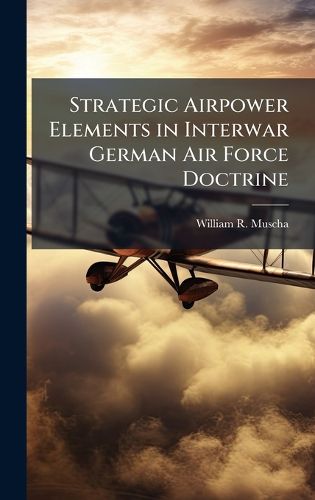Readings Newsletter
Become a Readings Member to make your shopping experience even easier.
Sign in or sign up for free!
You’re not far away from qualifying for FREE standard shipping within Australia
You’ve qualified for FREE standard shipping within Australia
The cart is loading…






This title is printed to order. This book may have been self-published. If so, we cannot guarantee the quality of the content. In the main most books will have gone through the editing process however some may not. We therefore suggest that you be aware of this before ordering this book. If in doubt check either the author or publisher’s details as we are unable to accept any returns unless they are faulty. Please contact us if you have any questions.
Germany reestablished its air force during the last half of the interwar period of 1919 to 1939, a period in which airpower theorists attempted to merge the new technology of aviation with traditional roles of the military. The Royal Air Force adopted the offensive use of airpower to attack enemy sources power as its primary mission and focused on defeating the enemy nation. Great Britain's national strategic situation, its lessons from World War I, and its air leadership all contributed toward this adoption. The German situation was different. Its lessons from World War I, its traditional views on the roles of its army, its strategic situation, and its fragmented air leadership contributed toward its adoption of an air doctrine that focused on defeating enemy military forces, not enemy sources of power. The Treaty of Versailles also restricted the size of its military and the kinds of aircraft it could build, affecting its air force's mission. This thesis addresses the development of a new technology and its adoption as either a doctrinal evolution or revolution. It also addresses the question of why one nation might see more value in strategic air doctrine rather than a doctrine focused on the enemy's military.
This work has been selected by scholars as being culturally important, and is part of the knowledge base of civilization as we know it. This work was reproduced from the original artifact, and remains as true to the original work as possible. Therefore, you will see the original copyright references, library stamps (as most of these works have been housed in our most important libraries around the world), and other notations in the work.
This work is in the public domain in the United States of America, and possibly other nations. Within the United States, you may freely copy and distribute this work, as no entity (individual or corporate) has a copyright on the body of the work.
As a reproduction of a historical artifact, this work may contain missing or blurred pages, poor pictures, errant marks, etc. Scholars believe, and we concur, that this work is important enough to be preserved, reproduced, and made generally available to the public. We appreciate your support of the preservation process, and thank you for being an important part of keeping this knowledge alive and relevant.
$9.00 standard shipping within Australia
FREE standard shipping within Australia for orders over $100.00
Express & International shipping calculated at checkout
This title is printed to order. This book may have been self-published. If so, we cannot guarantee the quality of the content. In the main most books will have gone through the editing process however some may not. We therefore suggest that you be aware of this before ordering this book. If in doubt check either the author or publisher’s details as we are unable to accept any returns unless they are faulty. Please contact us if you have any questions.
Germany reestablished its air force during the last half of the interwar period of 1919 to 1939, a period in which airpower theorists attempted to merge the new technology of aviation with traditional roles of the military. The Royal Air Force adopted the offensive use of airpower to attack enemy sources power as its primary mission and focused on defeating the enemy nation. Great Britain's national strategic situation, its lessons from World War I, and its air leadership all contributed toward this adoption. The German situation was different. Its lessons from World War I, its traditional views on the roles of its army, its strategic situation, and its fragmented air leadership contributed toward its adoption of an air doctrine that focused on defeating enemy military forces, not enemy sources of power. The Treaty of Versailles also restricted the size of its military and the kinds of aircraft it could build, affecting its air force's mission. This thesis addresses the development of a new technology and its adoption as either a doctrinal evolution or revolution. It also addresses the question of why one nation might see more value in strategic air doctrine rather than a doctrine focused on the enemy's military.
This work has been selected by scholars as being culturally important, and is part of the knowledge base of civilization as we know it. This work was reproduced from the original artifact, and remains as true to the original work as possible. Therefore, you will see the original copyright references, library stamps (as most of these works have been housed in our most important libraries around the world), and other notations in the work.
This work is in the public domain in the United States of America, and possibly other nations. Within the United States, you may freely copy and distribute this work, as no entity (individual or corporate) has a copyright on the body of the work.
As a reproduction of a historical artifact, this work may contain missing or blurred pages, poor pictures, errant marks, etc. Scholars believe, and we concur, that this work is important enough to be preserved, reproduced, and made generally available to the public. We appreciate your support of the preservation process, and thank you for being an important part of keeping this knowledge alive and relevant.